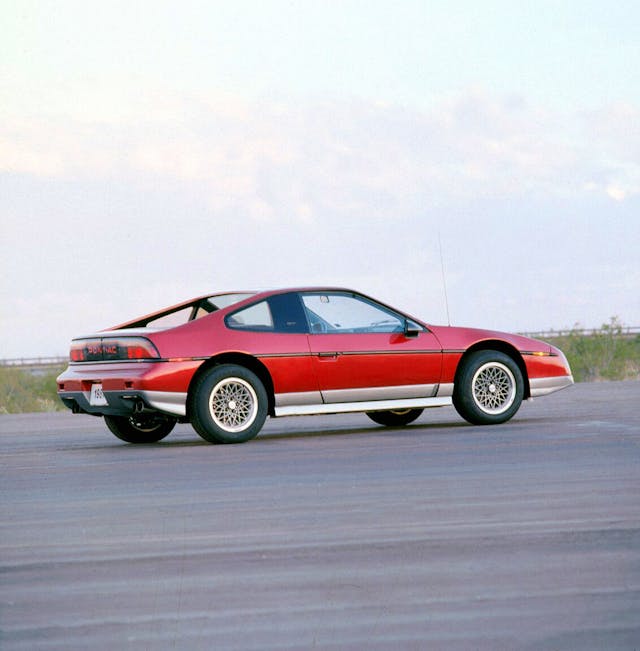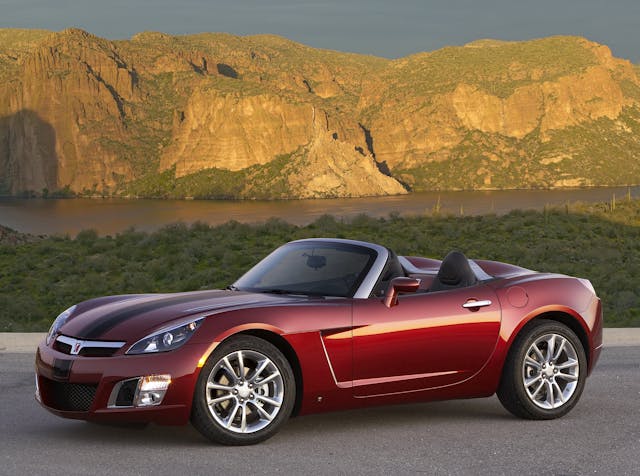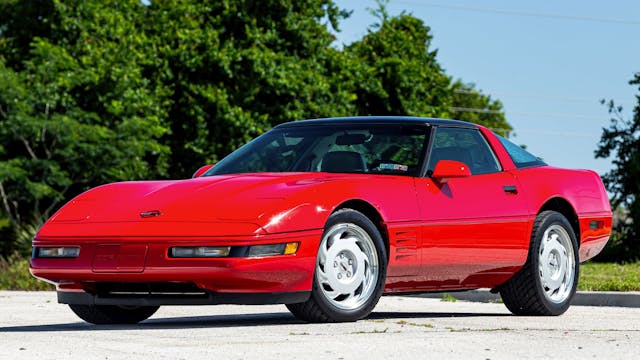Declare Independence From Mediocrity With These Three Underrated American Sports Cars
In the postwar sports car scene in America, European cars were more numerous and more popular. A generation later, Japanese sports cars proliferated yet home-grown choices remained limited. In fact, you could credibly argue that the number of true, two-seater American sports cars can be counted on two hands. Among them, there are three overlooked and somewhat misunderstood but very entertaining choices.
1988 Pontiac Fiero GT

The original Fiero was sold to GM bean counters as an efficient two-seater “commuter” car. Because power and sporty handling weren’t part of the original design brief, the 4-cylinder Iron Duke-powered 1984 Fiero contained a mish-mash of suspension parts from GM underachievers, like the Chevy Chevette and Pontiac Phoenix. It was at least exceedingly thrifty on fuel and actually quite safe despite some engine fires on early cars that tarnished its reputation. But sporty it was not.
Somehow, the Fiero found enough advocates in the vast GM bureaucracy to benefit from some actual development—a decently powerful and growly V-6 and a Getrag 5-speed were quickly added, along with a new flying buttress fastback body style. But the chef’s kiss came with the 1988 Fiero GT, with its revised suspension that was similar to what the engineers wanted in the beginning. While not designed by Lotus (as has been often stated), it certainly bore some of the hallmarks of their designs. Alas, GM killed the Fiero at the exact moment that they got it right, so the Fiero only lived up to its full potential for one year.

Because of its one-year greatness, the 1988 GT is the most valuable of the Fiero family, with a condition #2 (“excellent”) value of $22,000 compared to $17,200 for a 1986 GT. The #3 (“good”) condition value is a rather cheap $12,300. The 1988 Fiero Formula, which has most of the GT equipment but with less flashy styling, is cheaper still with a #2 value of $12,400 and a #3 value of $7700. And this is for a wedgy mid-engine two-seater with a V-6 in a 5-speed. Imagine how much it would be worth if it were European or Japanese.
2007-2009 Saturn Sky Redline Roadster

The Saturn Sky may well be one of the most overlooked sports cars in history. It’s the forgotten twin to the Pontiac Solstice, and many think that it’s the more handsome of the pair. While the 2.4-liter Ecotec-powered base model was somewhat unremarkable, the high-performance model—the Redline—was simply sensational. A new 2.0-liter direct injected and dual-scroll turbocharged engine offered 260hp (up from 177hp in the base car) and 260 lb-ft, while a limited-slip diff further added to the excitement. It was enough to push the Sky Redline to 60 in well under 6 seconds, while the classic rear-drive, front-engine layout and competitive price made it a real alternative to the Japanese and German small sports cars that dominated the segment.
With an excellent chassis, quick and communicative steering, and handsome styling, the Sky Redline should be remembered as one of the best American sports cars of all time. Motor Trend said that “the handling and the drivetrain” make the Sky Redline a true star. Alas, it left a legacy to last a lunchtime, and it seemed to disappear from memory along with the Saturn division itself in the wake of the Great Recession. None of this should stop you from seeking one out. Condition #2 values range from $21,300 to $23,600, and #3 values range from $14,600 to $16,900 depending on model year. The equivalent Pontiac Solstice GXP, which is more distinctive but less elegant than the Saturn, typically runs a few grand less.
1992-1996 Chevrolet Corvette LT1

The C4 (1984-96) generation of Corvette truly gets little respect. It was very nearly a clean-sheet design, and it certainly had the appearance of one, while some truly cool new tech would find its way into the car over its long production run. Although there were some shortcomings on the early cars, maybe the best thing to find its way into the C4 was the LT1 version of Chevy’s evergreen 5.7-liter pushrod V-8, introduced for the 1992 model year. More rev-happy, and pumping out an even 300 hp, it was a 55-hp leap over the L98 that preceded it and it made the complex, expensive and somewhat peaky DOHC ZR-1 feel almost redundant.
Road testers from the big-four mags of the day (Car and Driver, Motor Trend, Automobile, and Road & Track) were unanimous in their praise for the car, deeming it a massive improvement over the previous C4 Corvette. The chassis, which had seen significant improvement over the previous generation C3, remained more than up to the task, especially when working in tandem with Bosch ABS and traction control (the latter could be defeated by flipping a switch).
C4s, even the much better late LT1-powered cars, live in a somewhat uncomfortable middle ground price-wise, in that the subsequent C5 (1997-2004) Corvette is objectively a significantly better car for not much more money while the C3 that came before is a bit antiquated but also has a classic look and charm that the C4 lacks. Regardless, it’s positively criminal how undervalued these late C4s are. Really clean ones sell from the high teens to low-20s depending on year and body style, but a decent LT1-powered driver can be had for under 20 grand easily.
***
Check out the Hagerty Media homepage so you don’t miss a single story, or better yet, bookmark it. To get our best stories delivered right to your inbox, subscribe to our newsletters.



Owned a Solstice coupe, very pretty lines, lots of pony’s especially w the factory chip upgrade, but it is a undorted prototype. Hardtop won’t fit in trunk , cockpit to small, soft top a cruel joke… replaced it with a mx5RF and never looked back
After the same thing happened to me about a dozen times, I’ve given up on posting anything on this forum, waste of time, but let’s see if this goes through. If not I’m done trying to post and maybe done reading…
A lot of pluck per buck here. I really like 2-seat fun cars, if I wanted something other then what I’ve built (SBC MGB) these would get a look.
As soon as I saw Sky & Solstice on the list I was sure the comments would get “interesting”! Yes, German engineering & yes built in the USA. I was as sure the “Opel GT” name would pop up as I was certain someone would toss in the obligatory “Mini-Vette” handle into the mix.
OBTW: “Mini-Vette” is a term most of us that own the 68 –73 Opel GT don’t particularly care for because it was not “copied from the 68 Corvette” like so many believe. GM owned a controlling interest in Opel from 1929 until 2017 when it was sold. If one visits the Opel Museum on display are the designs & clay models dating back to 1960 for the Opel GT as well as the two running/driving cars that were shown at the Frankfurt Auto Show in 1965. Epic skills if they were “copied from the 68 Corvette” or they had a time machine we never heard about… eh? Wish I could post a picture here as also of interest (you can find it from your search engine) there was a 2016 Opel GT in the works that sadly went away when the company was sold. They did build one! I had my check book ready to buy one to park next to my 73 Opel GT. I had even planned on ordering a spare set of wheel as the “red front tires” I had mixed feelings on. LOL
Don’t get me wrong, I think every Corvette is beautiful, but if you think a C-4 you have not owned a Corvette, I have had a 79 Vette, nice car to have when you young and single, had a 93 rag, the 84 C-4 was such a piece of junk most of them are in junk yards, they tried to get it right over the years but never did, that’s why c-4’s are a dime a dozen, they finally made in my opinion the nicest corvette in 98 when you got a convertible, with a good engine, a trunk that takes two sets of golf clubs, great suspension new technology, balanced perfectly front to back , tip up head lamps, mine is a 6 speed and Carmine Red which at night is under the lights is beautiful, after that they had a run until they ruined the greatest North American sports car by trying to copy Ferrari and Lamborghini and made a mess of it, C-4 where a disaster, I think a C-5 was the time they got it all right.
the fiero was based more on the chev celebrity , maybe citation not a chevette
The lt1 in our 93 Z28 puts out good power and converted to modern computer is tune able snd eliminates optispark.
I would prefer the Solstice front with the Sky rear, but they didn’t make them that way. ;<)
And while the C5 Corvette may be better objectively than the later C4's, the C4 is SO much sleeker and better-looking, without the C5's bulbous butt.
I have a 2007 Pontiac solstice GXP I’m trying to sell right now. The car is in like new condition five speed manual transmission. I just don’t drive it. I have two Corvettes that I drive so I’m ready to sell the 2007 Solstice, only 10,500 miles.
One the information on the Fiero was initially incorrect. My friends dad was on the initial “P” concept car program, he snuck us into his dads office and showed us the initial plans for the car. We all thought it was a cool car and would buy one if it came out. This is a group of 20 somethings that had a collection of street rods, muscle cars and sports cars. The last generation was original plan for the car, in body design and drivetrain. It was the GM bean counters that screwed the hooch. In the early ’80s when interest rates for cars was 18 % or more The proposed manufacturing costs was deemed too high. So they junked down the car to be able to sell it at the price point the bean counters thought it should be. When interest rates dropped down to 6-7 % for a loan, they finally did the original design because people could afford a higher price point.
It’s nice to see that the Fieros are finally getting some deserved attention. I have a 1987 GT fastback and I love it. Ok, it’s not an 1988 but that’s fine with me. Also, my (83 year old) mother owns a 2008 Saturn Redline convertible she bought new. It’s her “daily driver” and only car. I think she might have about 30,000 miles on it.
Here is the deal. All these cars we need to keep in mind the era they are from.
As for the Fiero I have owned mine since new. It is a 1985 V6 and no issues. Yes 140 Hp is down today but it was good for the time.
I was a celebrity when I bought the car. I then became the idiot that bought one. Finally today I have again exper the celebrity status. I have been invited to shows and in several magazines including one later this month.
I originally wanted to buy a Trans Am but insurance was too much. I can say today I made the right choice. I have won at major car shows. Got laps in on the Indy speed way and when I go to cars and coffee there may be more Ferraris than cars like mine and they welcome me in as one of them.
For the money invested I have a lifetime of accomplishments and memories few other cars would have delivered.
There are no perfect cars. We just find the one that works best for us as we all want something different. I found a car that delivered more than I expected.
I have a C5 now that is a blast to drive and I enjoy. But I take it to an event it is just another C5. My Fiero is a bit modified with prototype Pontiac parts and is my own car.
But you show me a car I can point out issues with nearly all of them. The MR2 comes up but rust and service work is a major issue.
We all chose our own poison.
As for GM. They have built millions of cars that kept us rolling. They may not have been perfect or always pretty but the Cavalier and other GM cars with many miles fill the roads and parking lots as they keep rolling.
GM never supported the Fiero. The Corvette people did killed the Fiero as the C4 sales were in the tank and a C5 business case was difficult to get approved and ultimately they killed the Corvette.
The 1990 GT was coming with 230 hp and the Corvette team was concerned. They pointed out the GM 80 the FWD f body was canceled and that left the Fiero plant with no support for the volume needed.
GM competed internally as much externally and that has hurt them. They never worked as one but as many divisions.
I have to laugh here. The only value here is only for the diehard GM aficionados. I wouldn’t hold my breath on collector car values going up on these. The Saturn specifically. It’s NO Honda S2K. It will never appreciate even close to one. You have an orphan that is synonymous with a company who was on the brink. Known to cut corners with low quality and ho hum feel. It’s a shame as GM missed the boat here. You cannot reinvent the Miata. I will say its a car that looks better parked.
The Fiero is tainted. I don’t care if 1988 is the best year. It still emits the many problems that occured with the earlier cars. Think about building a car that is designed low on oil and massive recalls. It was also said the 1969 Corvair was the best year. It will never be a blue chip collector car. It will only be special to those passionate.
The Corvette? I think someone already answered it best. The platform widely used in Go Kart builds. It looks like any other C4. Nothing screams 1990’s more than cheap plastics and look I am wearing my New Ballance shoes.
I worked on a system used for painting the Fiero when it first came out (I work for an equipment vendor). It pioneered the use of high solids paint. There were beautiful metallic base / clear paints, yet they only released it in black red or white. Disappointment #1. Disappointment #2 was that Chevy (Corvette) kept them from releasing the 6 cylinder GT till it was too late. The fit and finish was better than most German cars, due to the high tech chassis and machined panel blocks. A lack of risk taking and politics doomed it to mediocrity.